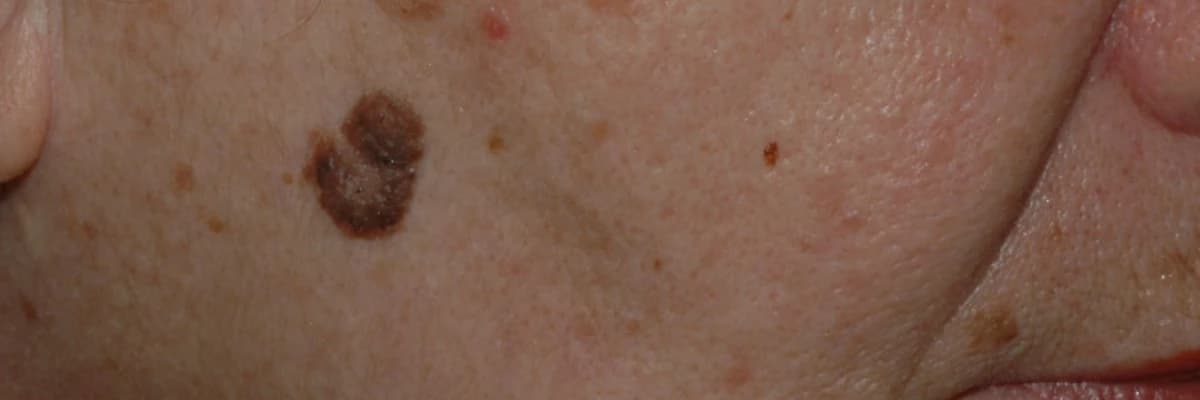Malignant Melanoma

Malignant Melanoma
The pigments that give our skin its color are produced by special cells in the skin. These cells are called melanocytes. Melanocyte cells secrete a dye called melanin, which protects the skin. The tanning of the areas exposed to the sun for a long time occurs with the secretion of melanin by melanocytes.
Nevus
Melanocyte cells form harmless skin tumors in almost everyone. They are usually brown colored and may be flat or raised from the skin. Among the people, these are called moles. Normally, nevi appear at various times after birth and their number increases in varying amounts from person to person. However, there are also congenital types and these are called congenital nevi. Their sizes are different. Rarely, they can be large enough to cover very large areas.
Melanoma
Melanocytes in our body can form skin tumors under some conditions that look like nevus but are very dangerous and oftentimes the cause is unknown. These are called melanoma or malignant melanoma.
Why does it happen?
Melanoma can develop from a pre-existing cancer-prone formation on the skin, or it can occur spontaneously in completely healthy skin. The cause of melanoma is not known exactly like in many cancers. However, some factors are known to trigger melanoma. These:
Ultraviolet rays
The responsible factor in the development of many melanomas is exposure to ultraviolet rays. Both ultraviolet A (UVA) and ultraviolet B (UVB) have carcinogenic effects. These rays are also available in commercial solariums. The belief that the sunbathes create a healthy body is common among the people. In fact, on the contrary, sun rays are the most damaging and rapid aging factor to our skin.
Sunburns
The most risky situations are the occurrence of sudden, severe and blistering sunburns that recur at regular intervals in areas that are rarely exposed to the sun. This is especially common in people who do not live by the sea during their summer holidays. In the past years, when sunscreen oils were not common, those who are a little older remember how often serious sunburns were encountered in the first days of sea holidays. Most melanomas occur in sun-exposed areas. However, melanoma can also occur in areas that are not exposed to the sun, such as the palms, soles and genitals.
Skin lesions that can subsequently turn into melanoma
Nevi (moles) on the skin can later turn into melanoma. These are mainly:
- Ordinary nevi (moles) that appear later.
- Dysplastic nevus (suspicious mole)
- Congenital nevus (congenital mole)
- Cellular blue nevus (blue mole)
Risk factors by severity
High risk situations:
- Sudden changes in moles (nevi) afterward
- Presence of dysplastic nevi in patients with a familial history of melanoma
- More than 50 nevi with a diameter of 2 mm or larger in a person
Conditions that pose a moderate risk:
- Melanoma in a family member
- Undergoing previous treatment for melanoma
- Presence of regional dysplastic nevi
- Congenital nevus
Situations that pose a slight risk:
- Immunosuppression treatments
- Sensitivity to sun rays
- Sudden and severe sunburn with previous blistering
- Freckling
Diagnosis
The diagnosis of melanoma is made only by taking a biopsy from a suspicious nevus and examining it in pathology. There are some situations that make a nevus suspicious. These:
- Fast growing
- Sudden color change
- Irregular appearance of the edges
- Unexplained ulceration or bleeding
Biopsy
Dermatologists can decide whether a nevus is dangerous or not. However, the definitive diagnosis can be made by completely removing the suspicious lesion and undergoing pathological examination. Apart from this, no laboratory examination or imaging (radiology MR, CT PET, etc.) methods make a definitive diagnosis and is unnecessary. However, these tests are useful in the follow-up of diagnosed and advanced patients. Two types of biopsy are taken:
- If the nevus is small, the whole is removed and sent for examination. During removal, it is beneficial to leave 1-2 mm of intact skin at the edges and to go down to the subcutaneous adipose tissue. For many tumors, such removal provides a complete cure. However, if the result is suspicious, further treatment is planned.
- If the nevus is large, a full-layered slice with a width of a few mm is taken from the most suspicious part to go under the skin and sent for analysis. Depending on the result, definitive surgery is planned.
Treatment
Treatment of skin melanoma should definitely be done by Plastic and Reconstructive Surgery specialists. In this treatment, both the tumor is removed with a safe margin of healthy skin and the lymph nodes where it can spread are checked. The thing to be considered while removing the tumor is to take it wide enough not to leave the tumor behind. This wide excision can lead to the deformity of the structure of the region. Only Plastic and Reconstructive surgery specialists can put this broken structure back in its place with special methods. Removing a smaller area than necessary so that the image does not deteriorate may cost the patient’s life. When caught in the early period, melanoma is a disease that can be completely cleared and destroyed by surgical removal. However, in the future, if the disease recurs despite surgical treatment, or if surgery is insufficient, other branches also come into play for treatments such as chemotherapy, radiotherapy, and immunotherapy.
Important notices
Most of the skin lesions are benign. Some of these can be removed by burning with laser devices, cautery devices and chemical substances or by freezing with cold application. These methods are not expensive as they do not require an operating room. There is also a false belief that they leave less scar. However, it has an important drawback. If these are suspicious lesions, it is not possible to understand in advance what the true diagnosis is and whether the treatment is appropriate. Because there is no part to examine pathologically. Experience is important in decision making, but in some cases even the most experienced eye may not be able to spot a small cancer or melanoma. When these are insufficiently burned or frozen, they recur more extensively after a while. The reason for this is not playing with moles, but the wrong treatment. No skin lesion should be treated before being sent for biopsy unless there is one hundred percent certainty. prof. Dr. Ege Özgentaş sends every tumor he removes for pathological examination, no matter how innocent it looks.
Conclusion
Malignant melanoma (or melanoma) is curable when caught early. For early diagnosis, moles on the body should be checked by dermatologists at regular intervals. In doubtful cases, appropriate surgical treatment should be performed by Plastic and Reconstructive surgeons. In the treatment of melanoma, aesthetic concerns should be completely set aside and focused on saving lives.



